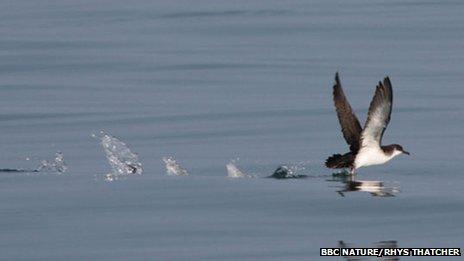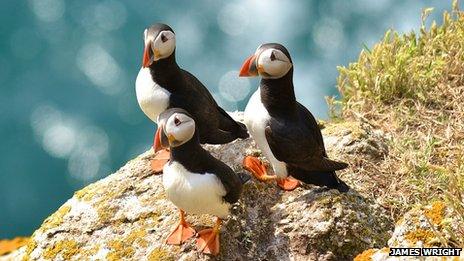Lundy seabird recovery 'success after rat cull'
- Published

The rise in Lundy's Manx shearwater population in 10 years from 300 pairs to 3,000 pairs was "outstanding news", the National Trust said
Culling the rat population on Lundy 10 years ago has led to a "striking" increase in the number of seabirds on the island, the National Trust has said.
The Lundy Seabird Recovery Project was set up in 2003 to help the Manx shearwater population, which had fallen to just 300 breeding pairs.
A survey this spring revealed a tenfold rise in numbers to 3,000 pairs.
It also recorded a substantial rise in other species, including puffins.
Wildlife haven
The previous decline in birdlife on Lundy was blamed on rats, which came via ships to the island off the North Devon coast and ate birds' eggs and attacked young chicks.
Dr David Bullock, head of nature conservation for the National Trust said: "Once the rats had gone from Lundy, the number of pairs of shearwaters on Lundy went from 100s to 1,000s in matter of a few years which is outstanding news.
"Such a rapid recovery is unlikely to have been due to "home bred" birds - shearwaters from other colonies must have settled to breed on the island.
"We do not know where these birds came from, but there is a massive shearwater colony on the islands off Pembrokeshire in Wales."

Ridding Lundy of rats has also helped puffin numbers rise from five to 80
The project has been run jointly by Natural England, the RSPB, the National Trust and the Landmark Trust,
Helen Booker, a senior conservation officer for the RSPB, the results of the latest survey were exciting and "better than expected".
"The rate of increase is an indication of just how important rat free islands like Lundy are as breeding site for seabirds," she said.
The survey showed puffin numbers rose from five to 80 birds, while guillemots, razorbills and shag numbers had increased substantially.
Island 'transformed'
Anecdotally, the National Trust said other species such as pygmy shrew and wheatear were also more numerous.
Derek Green, Lundy General Manager said the results showed the range of species the project had helped.
"Lundy has been a wildlife haven for many years, although rats were always a problem we had to live with," he said.
"Their removal has transformed the island for both wildlife and visitors alike, and we're watching with great anticipation and excitement as the cliffs and slopes of Lundy fill with the eerie calls of thousands of birds once again. "
A similar project is due to begin on the Isles of Scilly this summer.
- Published17 January 2013
- Published17 December 2012
- Published17 October 2012